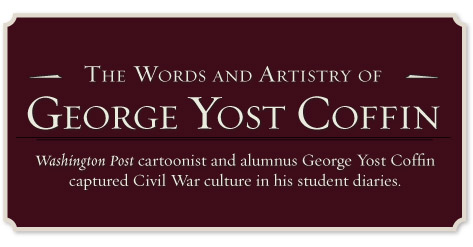
By Lyle Slovick

|
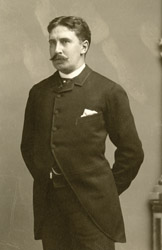
This portrait of George
Yost Coffin was taken around 1890.
|
Many fascinating characters have
been linked to GW in the 185 years since its founding.
Alumnus and Washington Post political
cartoonist George Yost Coffin is notable for the
characters he created and the diaries he kept
that describe life in Washington during the Civil
War.
Coffin graduated from Columbian College (the
original name of The George Washington University)
with an A.B. degree in 1869 and a Bachelor of
Laws degree in 1871. While a law student, he also
was an art tutor. Upon completion of law school,
Coffin became a clerk in the Revenue Marine division
of the Department of the Treasury, where he remained
employed until his death. This position provided
him a fixed income and the freedom to create his
art.
Coffin’s career as a political cartoonist
began in the mid-1870s with The Washington
Chronicle, the city’s first illustrated
newspaper. After its demise, he contributed to
Harper’s Weekly, Puck, and Judge
until 1883, when he took a job as an artist for
The Washington Hatchet, another short-lived
weekly paper. Puck and Judge
were popular political publications of the late
1800s and early 1900s, with colorful satirical
illustrations of the leaders of the period. Like
Harper’s, they had a wide audience.
During this time Coffin also contributed to a
number of papers in Washington and elsewhere,
including The Washington Star, Sunday
Herald, and The National Tribune.
In 1891, he gave up his freelance work and became
the official cartoonist for The Washington
Post.
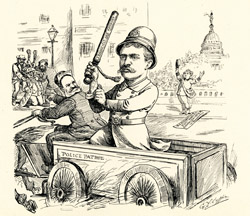
Coffin was known
as a humorist without malice, though he
covered timely political topics.
|

|
Coffin’s cartoons were nonpartisan. An
article from the Dec. 5, 1896, Columbian Call
student newspaper quoted him as saying: “Every
political situation has half a dozen comical sides
to it, according to the view point.” His
humor was wholesome, the article went on to say.
Said one who knew him, “He was a most charming
man at a social gathering. A born gentleman, a
gifted conversationalist, and a narrator with
hardly a peer in his circle.”
Coffin’s thorough knowledge of Washington,
its customs, and its characters gave his cartoons
a particular flavor. His work was without malice.
It was his rule never to make his cartoons offensive
or grotesque. “You need not make a man odious
or repulsive in order to caricature him,”
he once remarked. Even those he cartooned were
not offended and often called upon him for a friendly
interview. Among Coffin’s “victims”
were Grover Cleveland, William McKinley, and Theodore
Roosevelt, as well as Alexander “Boss”
Shepherd, head of Washington’s territorial
government. Coffin also illustrated a number of
books and was a dramatic critic for The Washington
Post, Sunday Herald, and Critic.
Coffin’s papers were donated to the University
in 1926 by Isabelle Solomons, a family friend,
and are maintained and made available to researchers
by the Department of Special Collections and University
Archives in Gelman Library.

|
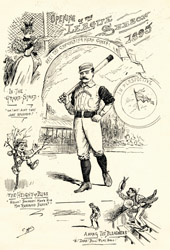
An avid baseball player,
Coffin wrote frequently about the sport
in his diaries.
|
Coffin was born in Pottstown, Pa., on March 30,
1850, and came to Washington with his parents
when he was 8 years old. He began a diary a year
later and continued it off and on until 1868.
The four diaries he kept record the folkways of
19th-century Washington and offer insights into
the political climate of the nation, as interpreted
by a precocious teenager.
Coffin’s connection with Columbian College
was established at an early age. George Whitefield
Samson, who became president of Columbian College
in 1859, was the pastor of the E Street Church
in Washington, and sometimes preached at the church
Coffin and his family attended. Other Columbian
College students and faculty members are mentioned
in the diary in regard to church services and
Sunday school.
Coffin’s childhood days were filled with
baseball, books—he mentions reading 220
from 1857 to 1868, including Dickens, Bunyan,
Irving, Tennyson, and Longfellow—and drawing
and painting. These interests proved to be lifelong,
as Coffin played baseball during his time at Columbian
College, was an excellent student, and turned
his artistic talent into a profession.

Coffin kept sketchbooks
of doodles and drawings. This drawing was
created after the Civil War and portrays
President Lincoln reviewing troops. Lincoln
visited the Columbian Hospital, located
on the College grounds, on at least one
occasion, in 1862.
|

|
While Coffin’s diaries were sporadically
kept, they do offer insight into life in Washington—and
on campus—during the Civil War. On July
12, 1864, he wrote of trying to go to Fort Stevens,
in the northern part of Washington, with a friend.
There was fighting there, and they were turned
back by guards. Walking home, they observed a
large detachment of troops, prompting Coffin to
observe, “The city undoubtedly is in great
danger. The firing at the forts is fairly audible
in the heart of the city.” Coffin also later
noted seeing troops marching up H Street, yet
the tone of his entries never conveyed a sense
of panic or prolonged tension. In fact, he didn’t
mention military matters much at all, focusing
instead on his daily routine.
Three days later, Coffin and another friend
procured passes to go to the battlefield. They
“started for the field which we soon reached,
we saw the graves of several of those who fell
in the fight, one man buried with a forefinger
left uncovered.” Unfazed, they observed
destruction around them and picked up souvenirs.
They met with three soldiers who “invited
us to lunch with them in their ‘crib’
which they called the ‘Hotel de posh.’”
After sharing a lunch of hardtack, pork and beans,
and coffee, the soldiers went back to work and
the boys returned home. “Our walk home was
a weary one, we being loaded down with about 95
cartridges a piece, besides other weighty trophies.
However we enjoyed ourselves very much.”

|

Coffin’s four
diaries date from 1859 to 1868. An entry
from Coffin’s diary, dated Nov. 9,
1864, records the results of the presidential
election, which was the source of “considerable
anxiety.”
|
At the end of the summer, it was time to go back
to school, which for Coffin was the Preparatory
School of the Columbian College. The College had
been founded in 1821 and was composed of five
buildings on “College Hill,” north
of Florida Avenue, N.W., between 14th and 15th
Streets. The Preparatory School played a significant
role in the first 76 years of the University.
It was designed primarily to afford thorough training
for admission to college. Coffin entered in 1862,
and records show that he took courses in geography,
history, Latin, Greek, and algebra, among others.
Tuition was $55 a year. Because Coffin did not
keep a diary during the first two years, we have
no record of his first-hand experiences.
On Sept. 19, 1864, he began recording daily
life at school. Coffin was a member of the Hermesian
Literary Society, serving as editor of its newspaper,
the Casket, in 1863. The Hermesians conducted
debates, which Coffin wrote about frequently:
“I found myself as a debater on the affirmative
side of the question ‘Should suicide be
considered as an evidence of courage or cowardice.’
It was decided in the affirmative,” he wrote
on Sept. 30, 1864. This society had a number of
prominent members in its time, including Otis
Mason, principal of the Preparatory School from
1861 to 1884, and later the head curator of the
Department of Anthropology at the Smithsonian;
John Larner, who served the University for 20
years as chairman of the Board of Trustees; and
Theodore Noyes, who later became editor of the
Washington Evening Star.

Coffin’s
cartoon “Our Inhospitable Hospitals”
appeared in The Washington Post March 20,
1895. A woman comes to the D.C. public hospital
with her sick child, only to be turned away.
The rules read: “Persons not requiring
the assistance of this hospital admitted
at all hours. No others need apply.”
|

|
As 1864 drew to a close, Coffin often commented
on the presidential race. On Nov. 8: “Today
the election for President takes place, and it
will be decided whether we are to have four more
years of bloodshed, misery, taxation and ruin,
or peace once more spread its wings over our distracted
land, bringing blessings and prosperity in its
train.” A week later he commented: “The
election has passed and we are doomed to another
four years of anarchy & disaster.” It’s
easy to tell who got young Coffin’s vote.
Even though he was no fan of Lincoln, Coffin
reported going with two friends to see the inaugural
procession, which until 1937 was held on March
4. “After having waited for some time in
the mud & rain, in the immense crowd that
lined the avenue, the president or rather his
closely shut carriage (for he was invisible) hove
in sight. He was attended only by his usual cavalry
guard and some of the marshals.” Coffin
noted that the day “opened with floods of
rain but about noon the clouds cleared away. Perhaps
this is ominous.”
As the war was drawing to a close, Coffin devoted
more attention to it in his diary. On April 5,
1865, he wrote of seeing “some terrible
scenes among the wounded who have arrived from
the front at Columbian Hospital.” When the
war began, the government took over the grounds
of the College and used it for two hospitals (the
other was Carver Hospital) as well as for soldiers’
barracks. Despite significant challenges, the
College and Preparatory School continued operations
during the war, and by 1865 the South was in its
death throes. On April 13, Coffin described the
city: “All the public and nearly every private
building are illuminated & tastefully trimmed
with flags, lanterns, wreaths, etc. Many of the
patriotic inscriptions were very appropriate.
Bands are playing, magnificent fireworks are being
set off and the city is a blaze of light…Every-one
is rejoicing at the prospect of peace.”

|

The George Coffin
Papers contain more than 900 sketches plus
many others in scrapbooks. There are a number
from Coffin’s childhood, some dated
as early as 1858, when he was 8 years old.
This one, titled “The Happy Family,”
is from that era.
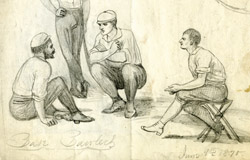
|
The next day brought horrible news. “At
about 10 p.m. during the third act of ‘Our
American Cousin’ [a play Coffin himself
had seen in February of that year] at Ford’s
Theater, where Miss Laura Keene is playing, a
pistol shot was fired in the private box of President
Lincoln & a man leaped upon the stage brandishing
a dagger, shouted ‘Sic Semper Tyrannis,
the South is avenged,’ rushed out, gained
his horse & escaped.”
The following day, he wrote: “The President
died at 22 min. past 7 this morning. Thus has
our rejoicing been changed into grief.”
On April 19, Coffin walked from his home at 354
New York Ave. to 14th Street and Pennsylvania
Avenue to see the funeral procession, and then
noted that he spent the remainder of the day playing
ball. Life went on for him and the nation.
On Sept. 27, 1865, Coffin began studies as a
freshman at Columbian College. He and his roommate,
Eugene Soper, chose Room 18 on the first story
of the main building as their quarters. Coffin
noted, “The building is being renovated
after its four years appropriation to hospital
purposes.”
President Samson was Coffin’s French teacher.
Coffin became a member of the Philophrenian Society,
another student debating group, and was editor
of its newspaper, the Spectator. The
post-war years are mostly full of news regarding
his studies, his friends, improvements to the
college grounds, a cholera panic, and the daily
routine of life, including his love of baseball.
After final examinations in June of 1866, Coffin
returned to Pottstown for summer vacation, and
the diary entries become sporadic after that.

This page of
sketches was drawn by Coffin as a freshman
at Columbian College. It also includes a
note from Nov. 11, 1865, in which he mentioned
hearing a lecture and writing a letter to
a friend.
|

|
On March 3, 1868, two days before going to the
Capitol to see the impeachment trial of President
Andrew Johnson, Coffin made this entry: “Attended
college and said my lessons. Performed likewise
an extraordinary [a]mount of loafing & howling.
The former is an ancient & well known [em]ployment,
which has been popular among college students
& indeed [m]ankind in general, from time immemorial.”
This entry is an excellent example of the sense
of humor found in his writing. In the last few
pages he spoke of drawing, which he had been doing
since a child. Legend has it that as a college
student he frescoed the walls of his dormitory
room with Shakespearean scenes and characters.
They were considered so good that officials spared
them from destruction when the interiors of the
building were painted, and they remained until
the building was razed.
George Coffin died Nov. 28, 1896, of locomotor
ataxia, syphilis of the spinal cord. How he was
stricken with this affliction we do not know.
For the last year of his life he was rendered
an invalid but was said to have remained in good
spirits and hopeful. After he died, his body was
taken from Washington back to Pottstown, where
he was buried in the family plot next to his mother.
He had no wife or children to survive him. What
is left today are extracts of his soul, freely
given, captured, and held fixed on the pages of
yellowing paper in the form of his writings and
drawings. These live on to tell a story of a time
gone by but not forgotten.
Lyle Slovick is Assistant University Archivist.
|